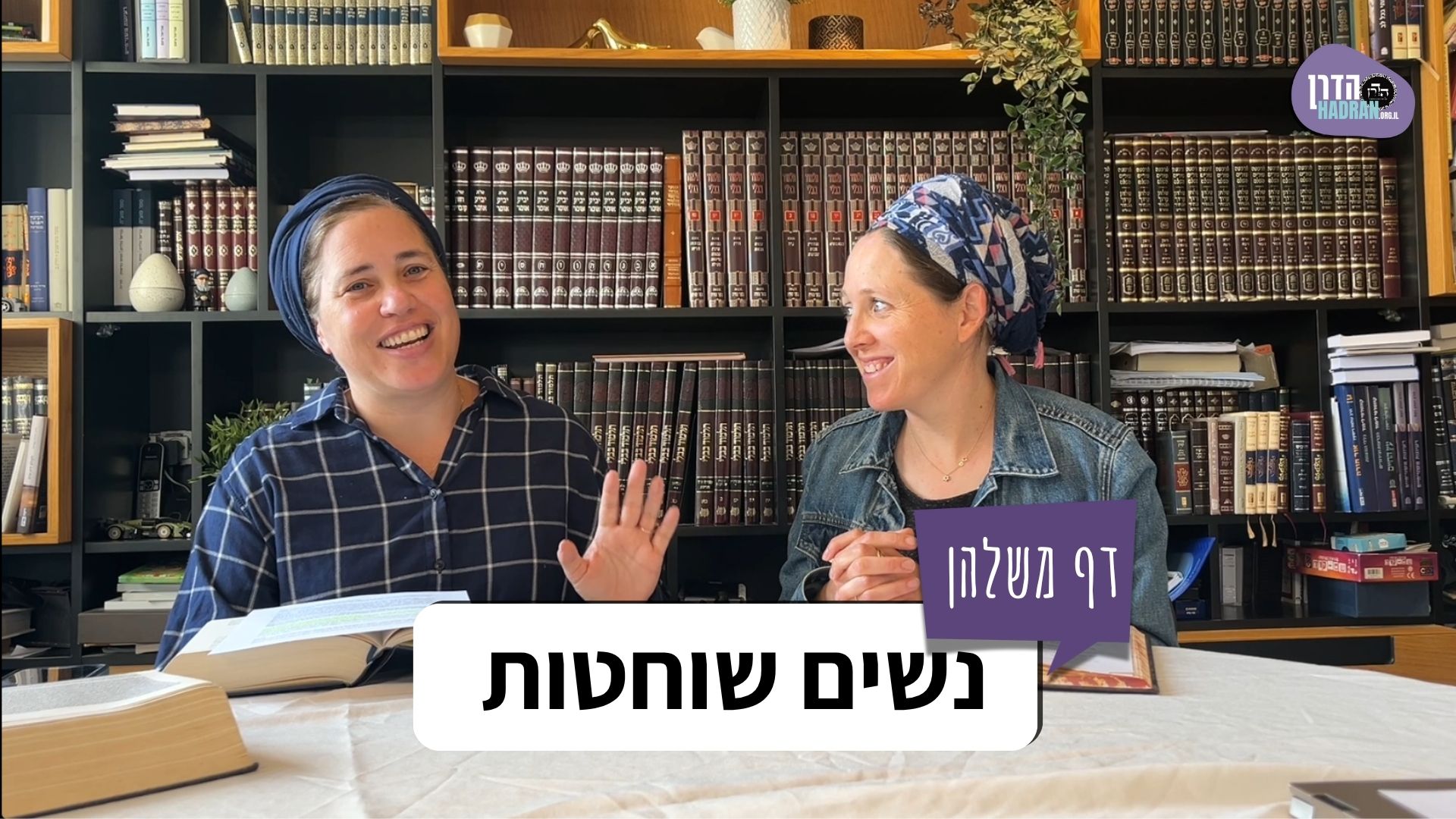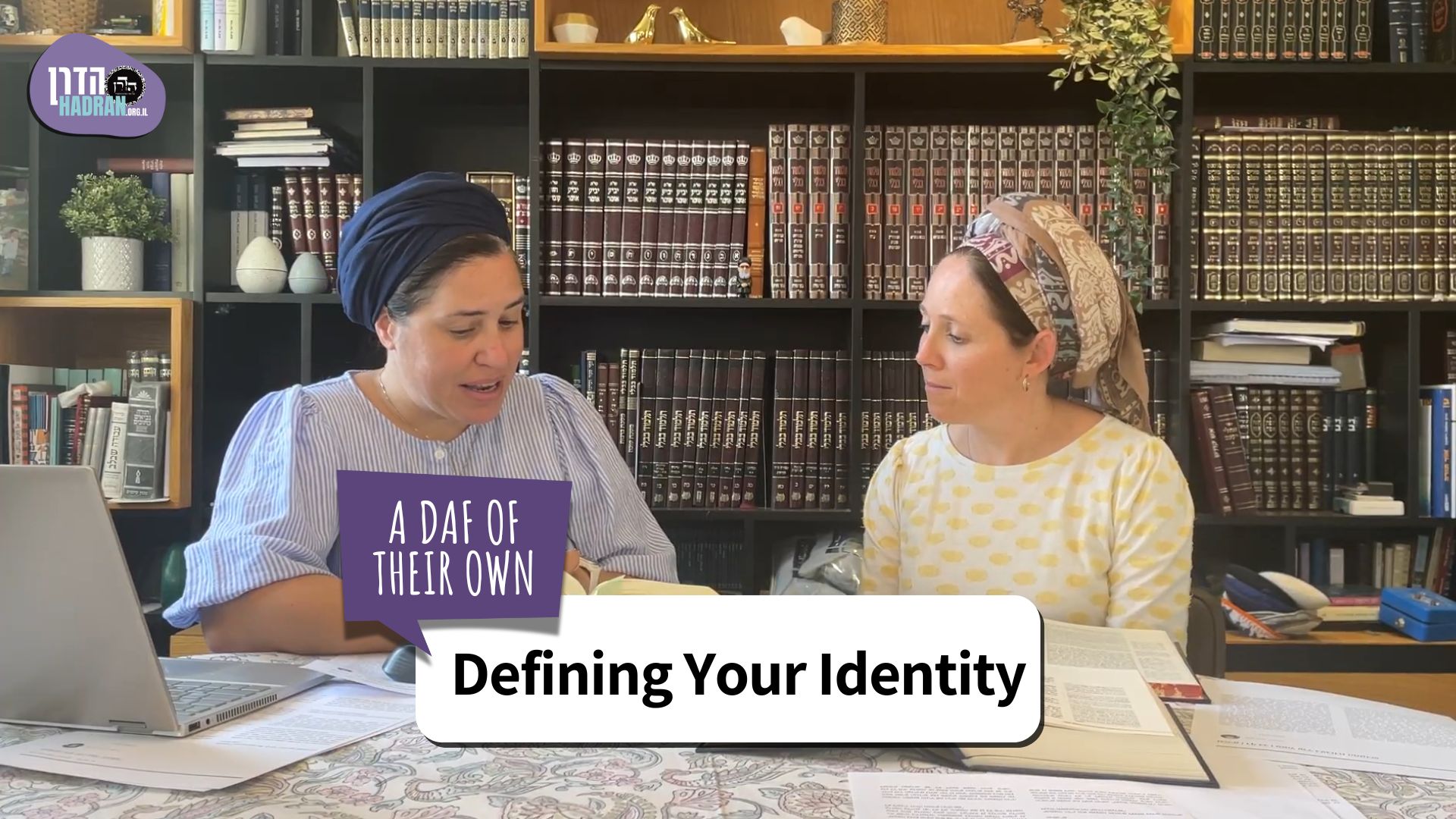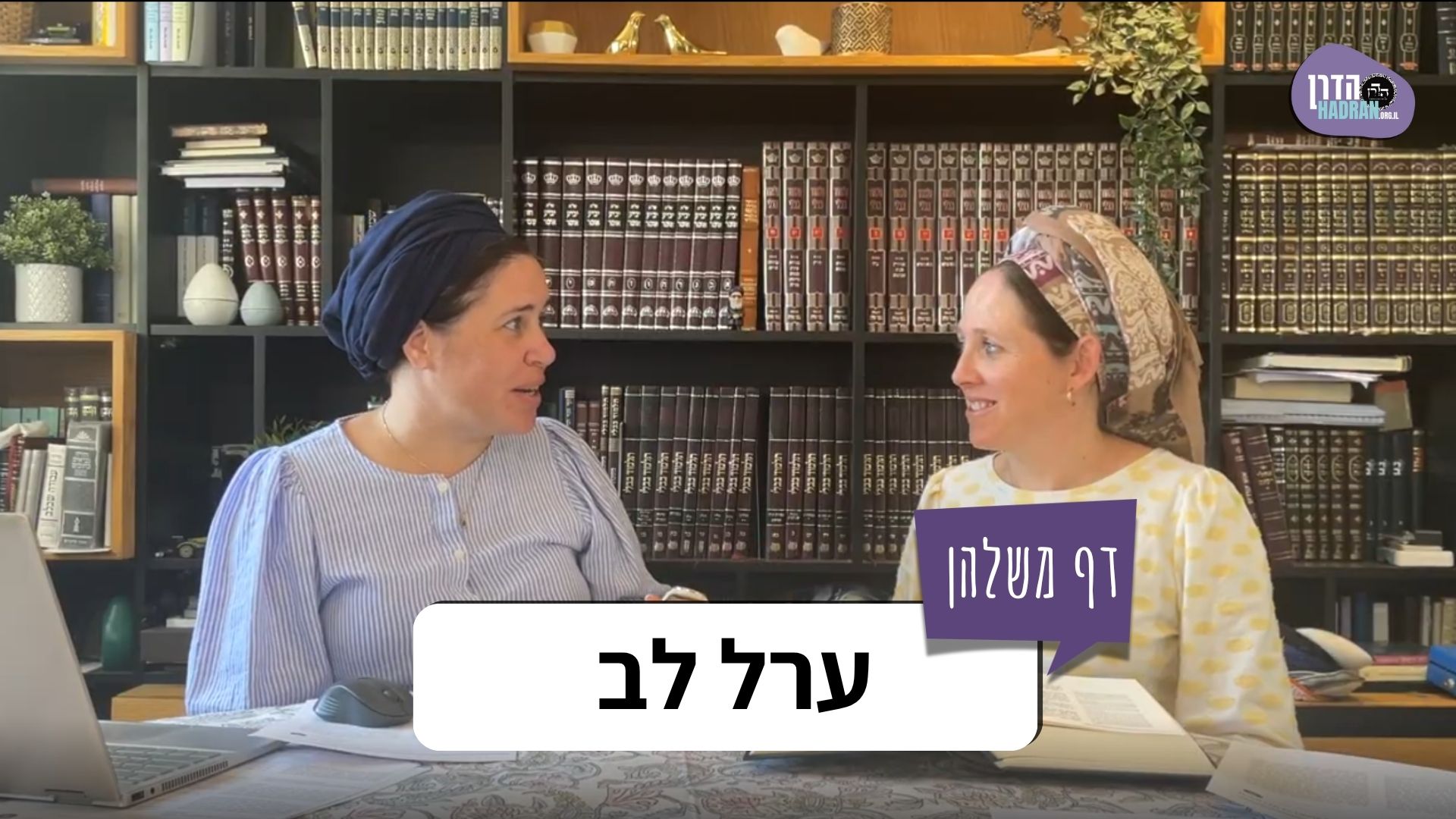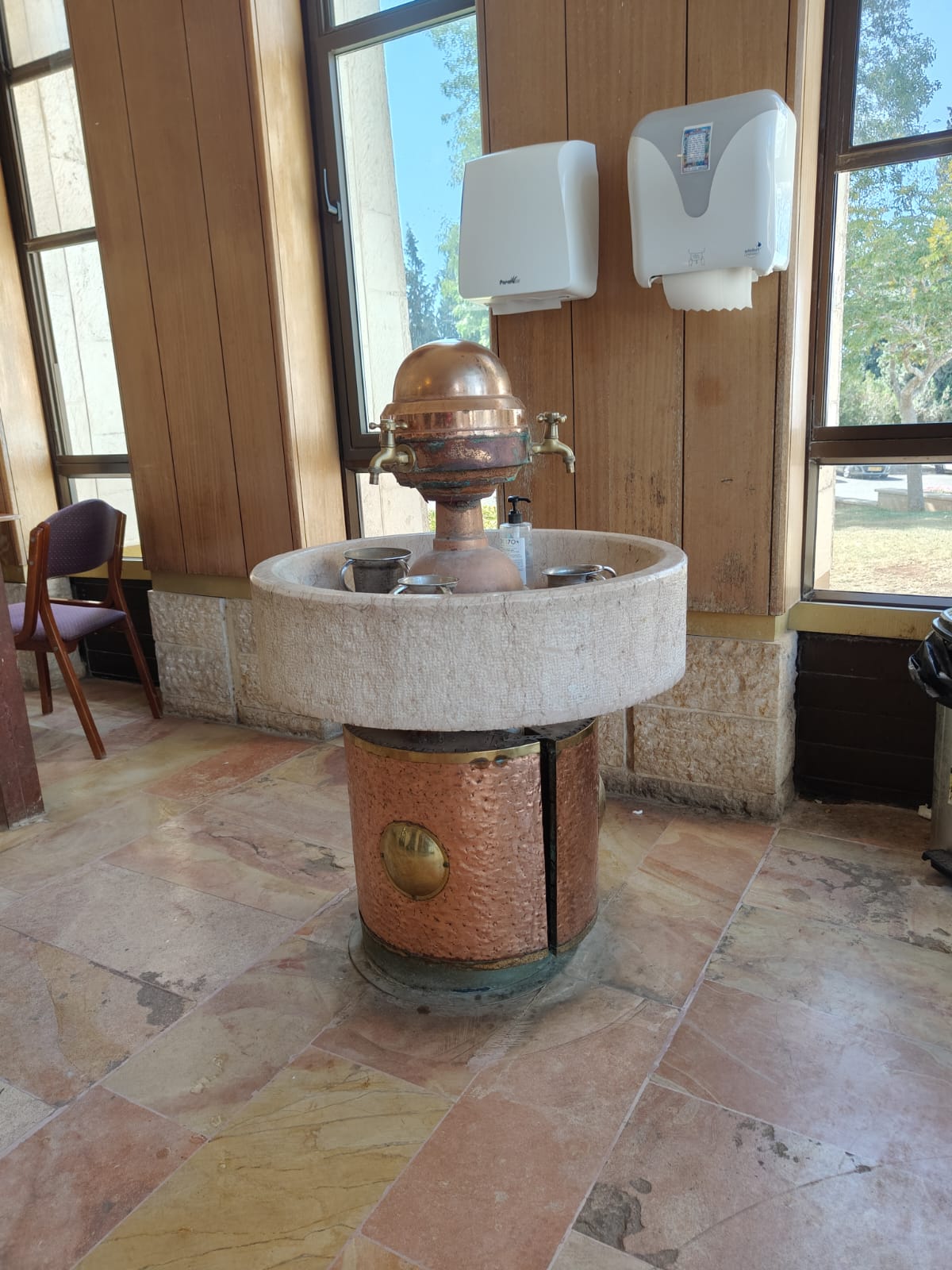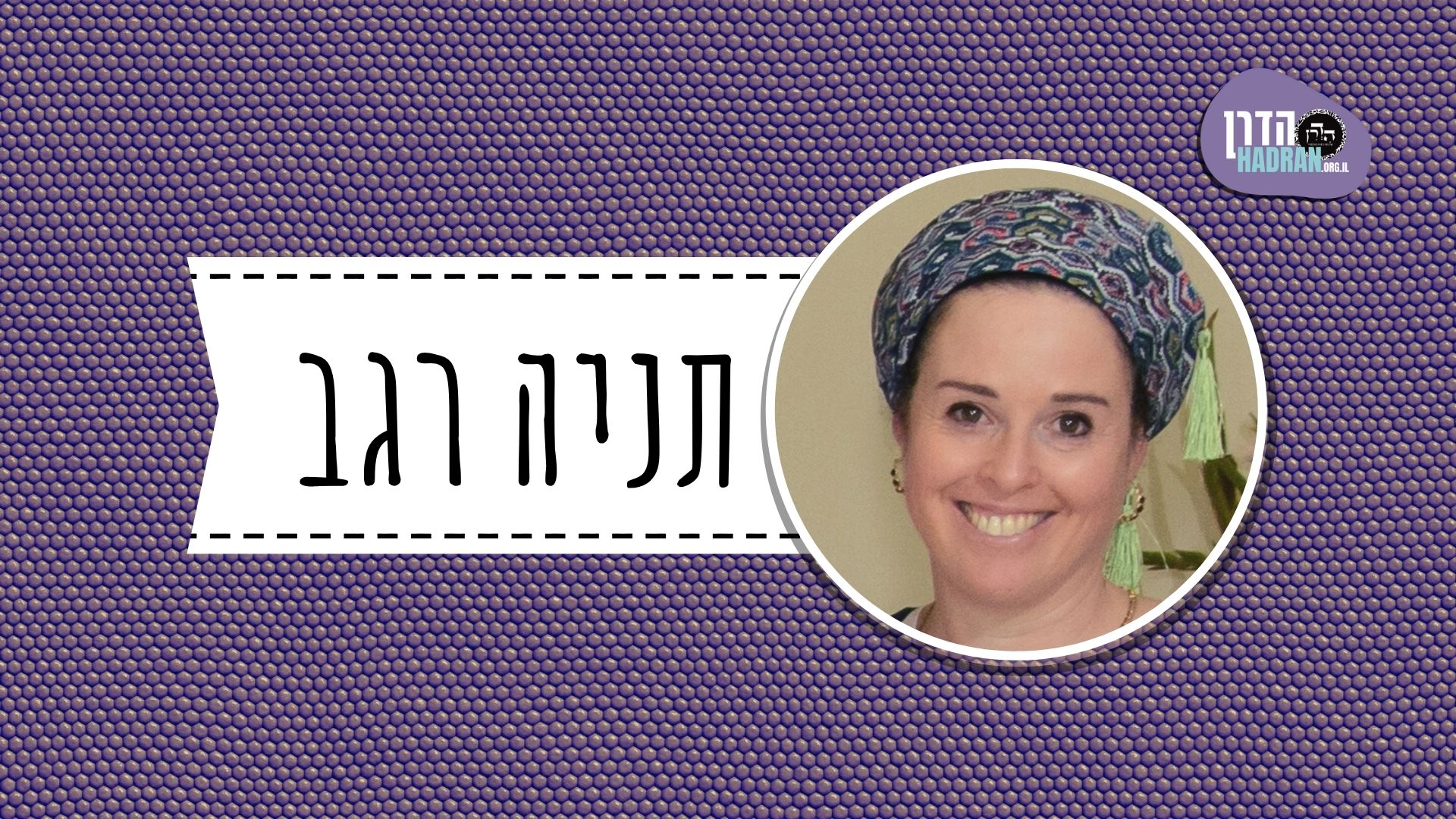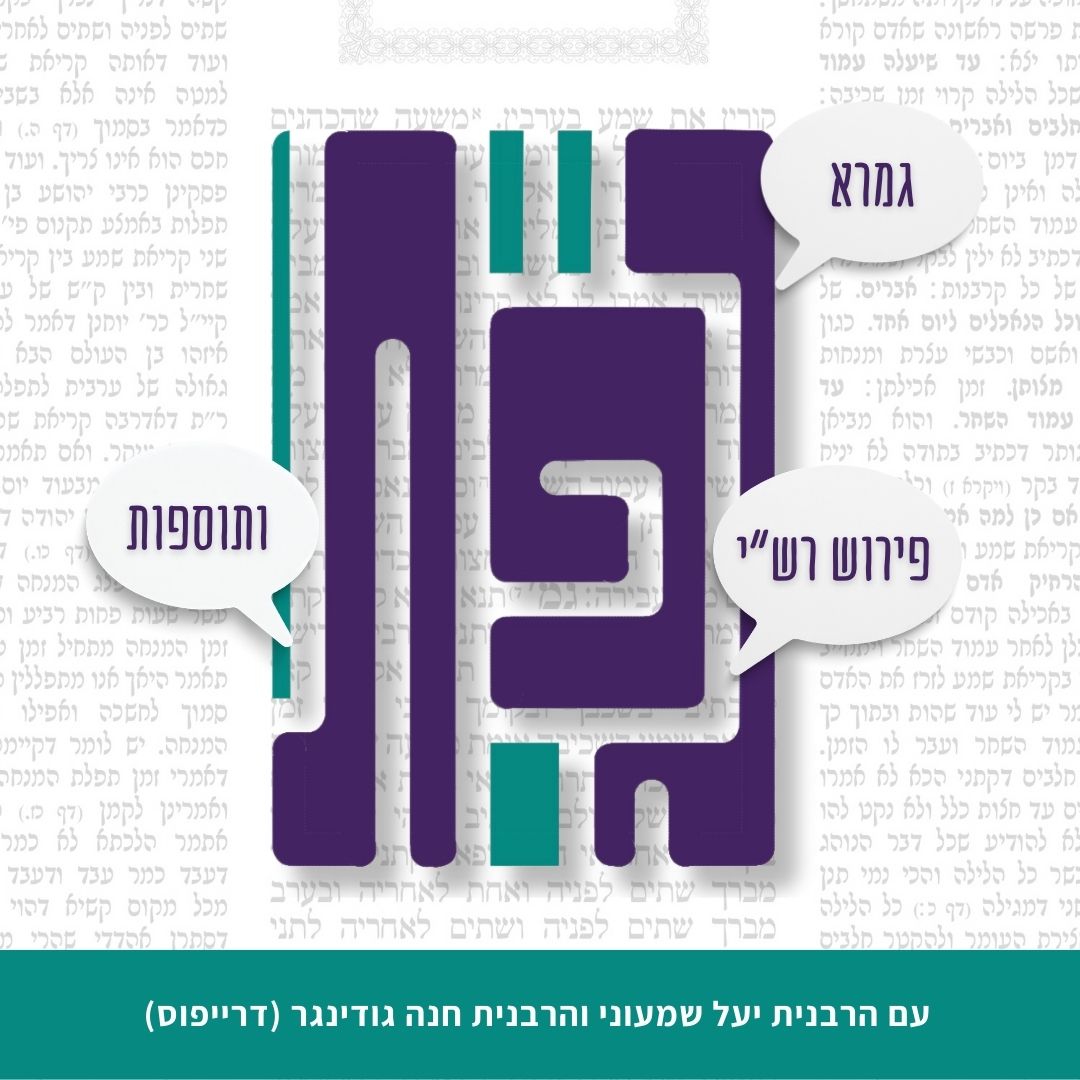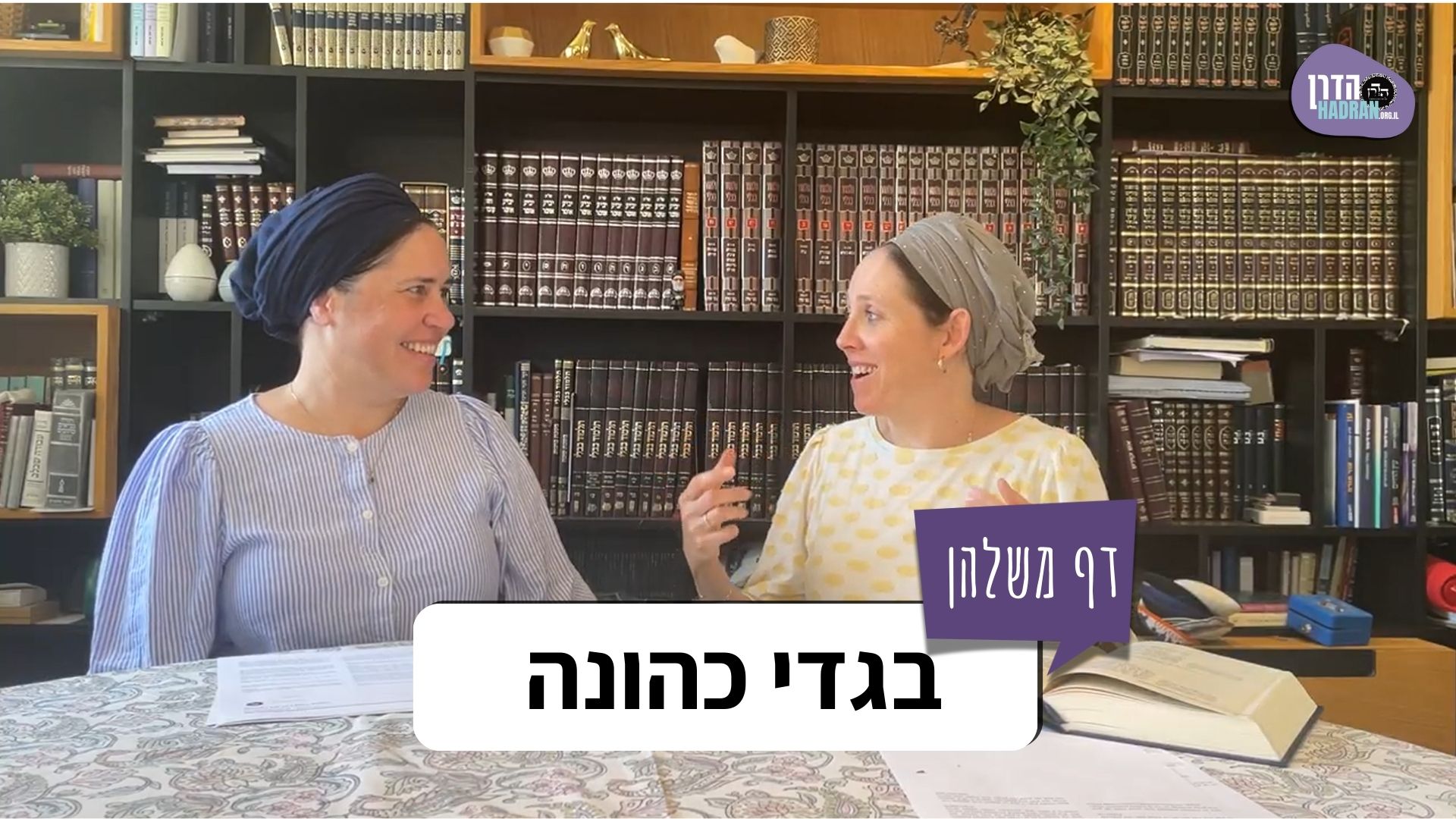The opinions of Rabbi Meir and the rabbis in the mishna regarding a limb of a fetus that left the body before the shechita and is cut off – are discussed. Would there disagreement also apply to a case of an animal that is slaughtered and has a limb hanging off.
Chullin 73
Share this shiur:
This month’s learning is sponsored by Beth Balkany in honor of their granddaughter, Devorah Chana Serach Eichel. “May she grow up to be a lifelong learner.”
Want to dedicate learning? Get started here:

This month’s learning is sponsored by Beth Balkany in honor of their granddaughter, Devorah Chana Serach Eichel. “May she grow up to be a lifelong learner.”
Delve Deeper
Broaden your understanding of the topics on this daf with classes and podcasts from top women Talmud scholars.
New to Talmud?
Check out our resources designed to help you navigate a page of Talmud – and study at the pace, level and style that fits you.
The Hadran Women’s Tapestry
Meet the diverse women learning Gemara at Hadran and hear their stories.
Chullin 73
כחתוך דמי
is regarded as though it were cut. Therefore, it is regarded as though the foreleg had already been severed from the body of the fetus, and the point of contact between them is not considered to be a concealed area. Rather, it is regarded as if the foreleg and fetus were two separate items that came into contact with each other. Consequently, the former can impart impurity to the latter.
כמאן כרבי מאיר דתנן כל ידות הכלים שהן ארוכות ועתיד לקצצן מטביל עד מקום מדה (דברי ר”מ
The Gemara asks: In accordance with whose opinion is this halakhic principle that Ravina cites? It is in accordance with the opinion of Rabbi Meir, as we learned in a mishna (Mikvaot 10:5): When a vessel is immersed in a ritual bath, it is purified only if all parts of the vessel are submerged at the same time. But with regard to any handles of vessels that are too long and therefore will ultimately be cut off, one must immerse them only until the point of their eventual size. Even though the part of the handle that will be cut off is not submerged, the vessel is nevertheless purified; this is the statement of Rabbi Meir. Evidently, Rabbi Meir holds that even though the handle is still physically attached, since that part of the handle stands to be cut off, it is already regarded as though it were cut off. Consequently, immersing the handle up until that point is regarded as immersing the entire vessel.
וחכמים אומרים) עד שיטביל את כולו
And the Rabbis say that the vessel is not purified until he immerses all of it, including the handle. Apparently, the Rabbis do not hold that an item that stands to be cut is regarded as though it was already cut, and Ravina’s explanation is in accordance only with the opinion of Rabbi Meir.
אפילו תימא רבנן חבורי אוכלין כמאן דמפרתי דמי ונגיעי בהדדי
The Gemara responds: You may even say that Ravina’s explanation is in accordance with the opinion of the Rabbis. The disagreement between the Rabbis and Rabbi Meir concerns utensils, but even the Rabbis agree that the connections between two pieces of food are disregarded, and the item is considered as though it is already separated into two pieces that are touching one another, and so ritual impurity can be imparted from one piece to another. Similarly, the fetus and the foreleg are considered like food in this regard. Therefore, it is considered as if they have already been separated and are touching, allowing the foreleg to impart impurity to the fetus.
בשלמא לעולא היינו דקתני חתכה אלא לרבינא מאי חתכה איידי דתנא רישא חתכה תנא נמי סיפא חתכה:
The Gemara asks: Granted, according to the explanation of Ulla that the fetus was rendered impure at the time of separation of the flesh of the fetus from the limb, this explanation is consistent with that which the mishna teaches, that the foreleg was severed from the body of the fetus. But according to the explanation of Ravina, the connection between the foreleg and fetus is like that of food, and even if the foreleg was never severed from the fetus it would still impart impurity to the fetus. What, then, is the reason the mishna states it was severed? The Gemara answers: Since the mishna needed to teach in the first clause that the foreleg was severed, it also taught in the latter clause that it was severed, for stylistic consistency, even though the halakha would apply even were it not severed.
וחכמים אומרים מגע טרפה שחוטה: טרפה שחוטה מי מטמיא אין כדאבוה דשמואל דאמר אבוה דשמואל טרפה ששחטה מטמאה במוקדשין:
§ The mishna states: And the Rabbis say: The flesh of a fetus that extended its foreleg outside the mother’s womb and whose mother was subsequently slaughtered has ritual impurity due to having been in contact with a tereifa that was slaughtered. The Gemara asks: Does a slaughtered tereifa impart impurity? The Gemara answers: Yes, and this is in accordance with the statement of Shmuel’s father, as Shmuel’s father says: The Sages decreed that a tereifa that one slaughtered imparts impurity to sacrificial animals, i.e., it will disqualify them if it comes in contact with them.
מה מצינו בטרפה ששחיטתה מטהרתה אף שחיטת בהמה תטהר את העובר:
§ The mishna cites the Rabbis’ rationale for their opinion: Just as we found in the case of a tereifa that its slaughter renders it ritually pure according to Torah law, i.e., it prevents it from having the ritual impurity of a carcass, despite not rendering the animal permitted for consumption, so too, the slaughter of the mother animal should render the limb of its fetus that left the womb ritually pure, despite the fact that it is prohibited for consumption.
תניא אמר להן רבי מאיר וכי מי טיהרו לאבר זה מידי נבלה שחיטת אמו א”כ תתירנו באכילה
The mishna itself proceeds to cite Rabbi’s Meir’s response to this claim. The Gemara here cites a different version of his response based on that which is taught in a baraita: Rabbi Meir said to the Rabbis: But what renders this limb pure from the impurity of a carcass? You might say it is the slaughter of its mother, but if so, the act of slaughter should also permit it even for consumption.
אמרו לו הרבה מצלת על שאינו גופה יותר מגופה שהרי שנינו חותך מן העובר שבמעיה מותר באכילה מן הטחול ומן הכליות אסור באכילה
The Rabbis said to him: The slaughter of an animal has a greater effect in shielding that which is not part of its body from having the ritual impurity of a carcass than that which is part of its body, as is apparent from that which we learned in the mishna (68a): If, prior to slaughtering an animal, one severs pieces from a fetus that is in its womb, leaving those pieces in the womb, their consumption is permitted by virtue of the slaughter of the mother animal. By contrast, if one severs pieces of the spleen or of the kidneys of an animal and then slaughtered it, then even if those pieces were left inside the animal, their consumption is prohibited.
מאי קאמר אמר רבא ואמרי לה כדי חסורי מחסרא והכי קתני אמר להן ר’ מאיר וכי מי טהרו לאבר זה מידי נבלה שחיטת אמו אם כן תתירנו באכילה אמרו לו טרפה תוכיח ששחיטתה מטהרתה מידי נבלה ואינה מתירתה באכילה
The Gemara clarifies the response of the Rabbis: What are the Rabbis saying? Rava said, and some say it unattributed [kedi] to any particular Sage, that the baraita is incomplete, and this is what it is teaching: Rabbi Meir said to the Rabbis: But what renders this limb pure from the impurity of a carcass? You might say it is the slaughter of its mother, but if so, it should also permit it even for consumption. In response the Rabbis said to him: Let the halakha of a tereifa prove the point, as its slaughter renders it pure from the impurity of a carcass but it does not permit it for consumption. Similarly, the slaughter of the mother animal should render pure even the foreleg of its fetus, even if it does not permit it for consumption.
אמר להן לא אם טיהרה שחיטת טרפה אותה דבר שהיא גופה תטהר את האבר דבר שאינו גופה אמרו לו הרבה מצלת על שאינו גופה יותר מגופה שהרי שנינו חותך מן העובר שבמעיה מותר באכילה מן הטחול ומן הכליות אסור באכילה
Rabbi Meir said to them: No, even if the slaughter of a tereifa renders the animal itself pure from having the impurity of a carcass, that is true with regard to something that is part of its own body. Does it necessarily follow that it should also render pure the limb of its fetus, which is something that is not part of its own body? The Rabbis said to him: The slaughter of an animal has a greater effect in shielding that which is not part of its body from having the impurity of a carcass than that which is part of its body, as is apparent from that which we learned in the mishna at the beginning of the chapter: If one severs pieces from a fetus that is in an animal’s womb and then slaughters the mother animal, their consumption is permitted. By contrast, if one severs pieces of the spleen or of the kidneys of an animal and then slaughters it, their consumption is prohibited.
תניא נמי הכי אמר להן רבי מאיר וכי מי טיהרו לאבר זה מידי נבלה אמרו לו שחיטת אמו א”כ תתירנו באכילה אמרו לו טרפה תוכיח ששחיטתה מטהרתה מידי נבלה ואינה מתירתה באכילה
The Gemara notes that this clarification of Rava is also taught explicitly in a baraita: Rabbi Meir said to the Rabbis: But what renders this limb pure from the impurity of a carcass? The Rabbis said to him: It is the slaughter of its mother. Rabbi Meir responded: But if so, it should also permit it even for consumption. In response the Rabbis said to him: Let the halakha of a tereifa prove the point, as its slaughter renders it pure from the impurity of a carcass but it does not permit it for consumption. Similarly, the slaughter of the mother animal should render pure even the foreleg of its fetus, even if it does not permit it for consumption.
אמר להן אם טיהרה שחיטת טרפה אותה ואת האבר המדולדל בה דבר שגופה תטהר את העובר שאינו גופה
Rabbi Meir said to them: Even if the slaughter of a tereifa renders the animal itself pure, and likewise the slaughter of any animal renders the limb that was partially cut from it but still hangs from it pure from imparting the impurity of a carcass despite being prohibited for consumption, that is the halakha with regard to something that is part of its own body. Does it necessarily follow that it should also render pure the limb of its fetus, which is something that is not part of its own body?
אמרו לו הרבה מצלת על שאינו גופה יותר מגופה שהרי שנינו חותך מן העובר שבמעיה מותר באכילה מן הטחול ומן הכליות אסור באכילה
The Rabbis said to him: The slaughter of an animal has a greater effect in shielding that which is not part of its body from imparting the ritual impurity of a carcass than that which is part of its body, as is apparent from that which we have learned in the mishna above: If one severed pieces from a fetus that was in an animal’s womb and then slaughtered the mother animal, their consumption is permitted. But if one severed pieces of the spleen or of the kidneys of an animal and then slaughtered it, their consumption is prohibited.
אמר רשב”ל כמחלוקת בעוברין כך מחלוקת באיברין
§ Rabbi Shimon ben Lakish said: Just as there is a dispute between Rabbi Meir and the Rabbis with regard to fetuses, concerning whether the slaughter of the mother prevents a limb that emerged from the womb from having the impurity of a carcass, so too, they have a parallel dispute with regard to limbs of an animal that were partially cut from it but still hanging from it, whether the slaughter of the animal prevents such limbs from having the impurity of a carcass.
ורבי יוחנן אמר מחלוקת באבר דעובר אבל באבר דבהמה דברי הכל שחיטה עושה ניפול
And Rabbi Yoḥanan said: Their dispute is only with regard to a limb of a fetus that emerged from the womb, but with regard to a limb hanging from an animal, everyone agrees that the slaughter of the animal renders such a limb as though it had already fallen off prior to the slaughter, and the slaughter does not prevent the limb from having the impurity of a carcass.
א”ר יוסי בר’ חנינא מ”ט דר’ יוחנן אליבא דרבנן האי אית ליה תקנתא בחזרה והא לית ליה תקנתא בחזרה
Rabbi Yosei, son of Rabbi Ḥanina, said: What is the reason for the distinction made by Rabbi Yoḥanan concerning the opinion of the Rabbis that the slaughter of an animal renders pure the limb of its fetus, but does not render pure a limb hanging from the animal itself? The reason is that this limb of the fetus that emerged from its womb has a means of rectification by returning back inside the womb, in accordance with the opinion that it will then be permitted for consumption by virtue of the slaughter of the mother animal. But this hanging limb does not have a means of rectification by returning, as it cannot be reattached to the animal’s body.
מיתיבי אמר להם ר’ מאיר לא אם טיהרה שחיטת טרפה אותה ואת האבר המדולדל בה דבר שגופה תטהר את העובר דבר שאינו גופה
The Gemara raises an objection to Rabbi Yoḥanan’s opinion from the baraita cited above: Rabbi Meir said to them: No, even if the slaughter of a tereifa renders pure the animal itself and similarly the slaughter of any animal renders pure the limb that is hanging from it from having the impurity of a carcass, this is true with regard to something that is part of its own body. Does it necessarily follow that it should also render pure the limb of its fetus, which is something that is not part of its own body?
בשלמא לרבי שמעון בן לקיש לדבריהם קאמר להו לדידי לא שנא אבר דעובר ולא שנא אבר דבהמה כי הדדי נינהו
Rabbi Meir’s statement appears inconsistent with his opinion, as he holds that a hanging limb is not rendered pure by slaughtering the animal. The Gemara suggests that this difficulty can be resolved only according to Rabbi Shimon ben Lakish’s version of the Rabbis’ opinion, but not according to Rabbi Yoḥanan’s version. Granted, according to Rabbi Shimon ben Lakish, one can explain that Rabbi Meir was speaking in accordance with the statement of the Rabbis, as follows: According to my own opinion, there is no difference with regard to the limb of a fetus, and there is no difference with regard to a limb hanging from an animal; they are the same in that the slaughter of the animal does not render either of them pure. Accordingly, Rabbi Meir must have been speaking in accordance with the opinion of the Rabbis that a limb hanging from an animal is rendered pure by the animal’s slaughter.
אלא לרבי יוחנן קשיא
But according to Rabbi Yoḥanan, who holds that both the Rabbis and Rabbi Meir agree that a limb hanging from an animal is not rendered pure by the animal’s slaughter, Rabbi Meir’s statement is difficult, as it is inconsistent with both his opinion and the Rabbis’ opinion. The Gemara concedes the challenge.
אלא אי אתמר הכי אתמר אמר רבי שמעון בן לקיש כמחלוקת בעוברים כך מחלוקת באיברין ורבי יוחנן אמר מחלוקת באבר דעובר אבל באבר דבהמה ד”ה אין שחיטה עושה ניפול
Rather, if such a dispute was stated, it was stated like this: Rabbi Shimon ben Lakish said: Just as there is a dispute between Rabbi Meir and the Rabbis with regard to fetuses whose limbs emerged from the womb, so too, they have a parallel dispute with regard to limbs hanging from an animal. And Rabbi Yoḥanan said: Their dispute is only with regard to the limb of a fetus that emerged from the womb; but with regard to a limb hanging from an animal, everyone agrees that the slaughter of the animal does not render such a limb as though it had already fallen off prior to the slaughter, and does not impart the impurity of a carcass. According to this version of Rabbi Yoḥanan’s understanding of the dispute, Rabbi Meir’s statement is consistent even with his own opinion.
א”ר יוסי בר’ חנינא מ”ט דרבי יוחנן אליבא דר”מ האי גופה והאי לאו גופה
Rabbi Yosei, son of Rabbi Ḥanina, said: What is the reason for the distinction made by Rabbi Yoḥanan concerning the opinion of Rabbi Meir, that the slaughter of an animal does not render pure the limb of its fetus, but it does render pure a limb hanging from the animal itself? It is that this hanging limb is part of the animal’s body, but that, the limb of the fetus, is not part of its body.
אמר רב יצחק בר יוסף א”ר יוחנן הכל מודים שמיתה עושה ניפול ואין שחיטה עושה ניפול
§ The Gemara continues to elucidate the dispute between Rabbi Meir and the Rabbis. Rav Yitzḥak bar Yosef says that Rabbi Yoḥanan says: Everyone agrees that the death of an animal by means other than slaughter renders a limb as though it had already fallen off prior to the animal’s death. Therefore, it will not have the impurity of a carcass, but it will have the impurity of a limb taken from a living animal. And likewise, everyone agrees that the slaughter of the animal does not render a limb as though it had already fallen off prior to the slaughter, and therefore it will not have the impurity of a carcass.
במאי עסקינן אילימא באבר דעובר מיפלג פליגי אלא באבר דבהמה מיתה תנינא שחיטה תנינא
The Gemara clarifies: What are we dealing with here? If we say we are dealing with a limb of its fetus that emerged from its womb, Rabbi Meir and the Rabbis explicitly disagree with regard to this case. Rather, we are dealing with a limb hanging from an animal. But if so, Rabbi Yoḥanan’s statement is unnecessary. With regard to a hanging limb, we already learn about the effect of the death of the animal in a mishna elsewhere, and we already learn about the effect of the slaughter of the animal in a mishna elsewhere.
מיתה תנינא מתה הבהמה הבשר צריך הכשר והאבר מטמא משום אבר מן החי ואינו מטמא משום אבר מן הנבלה דברי ר’ מאיר
The Gemara elaborates: We already learn about the effect of the death of an animal in the mishna (127b): If the animal died without slaughter, any hanging flesh needs to be rendered susceptible to contracting ritual impurity in order to become impure. This is accomplished by coming in contact with liquid, with the owner’s approval. The reason is that its halakhic status is that of flesh severed from a living animal, which is ritually pure and does not have the status of an unslaughtered carcass. And a hanging limb imparts impurity as a limb severed from a living animal, but does not impart impurity as a limb from a carcass; this is the statement of Rabbi Meir. Evidently, Rabbi Meir holds that upon the animal’s death, anything hanging from the animal is considered as though it had already fallen off before the animal’s death. Since the mishna does not record that the Rabbis disagree, it would appear that they agree.
שחיטה נמי תנינא נשחטה בהמה הוכשרו בדמיה דברי ר”מ ר”ש אומר לא הוכשרו
Likewise, we already learn about the effect of the slaughter of an animal in the same mishna: If the animal is slaughtered, they, the limb and the flesh hanging from it, are thereby rendered susceptible to impurity, by coming in contact with its blood. Blood is one of the seven liquids that render foods susceptible to impurity and its presence is considered to be with the approval of the owner, as it makes the meat look redder and fresher; this is the statement of Rabbi Meir. Rabbi Shimon says: They were not rendered susceptible to impurity through the animal’s own blood, but only once they were wet with another liquid, with the owner’s approval. It is apparent that both opinions in that mishna agree that the limb does not have the impurity of a limb severed from a living animal. Evidently, they hold that the slaughter does not render the hanging limb as though it had already fallen off beforehand.
אי מההיא ה”א מאי הוכשרו אבשר
Given that the mishna has already taught both halakhot, what was the necessity of Rabbi Yoḥanan’s statement? The Gemara answers: If these halakhot were derived only from that mishna, I would say that actually, slaughter does render a hanging limb as though it had already fallen off beforehand, and such a limb would have the impurity of a limb severed from a live animal. If so, what does the mishna mean when it states: They are rendered susceptible to impurity by coming in contact with its blood? Ostensibly, the intention is that both the limb and the flesh must be rendered susceptible to impurity, which indicates that the limb does not have any impurity of its own. The Gemara explains: One would have explained that the need to be rendered susceptible to impurity is referring only to the flesh, as flesh severed from a living animal does not have any impurity of its own.
והא הוכשרו קתני מהו דתימא חד לבשר הפורש מן הבהמה וחד לבשר הפורש מן האבר
The Gemara objects: But the mishna teaches: They are rendered susceptible, in the plural, which is apparently referring to both the flesh and the limb, which were mentioned previously in the mishna. The Gemara explains: You might say that the plural is used because the statement is referring to two types of hanging flesh that upon slaughter are considered to have been separated from a living animal: One is for flesh that separates from the body of the animal, and the other one is for flesh that separates from the hanging limb. Neither type has its own impurity, so they must be rendered susceptible to impurity by coming in contact with liquid.
ומאי אולמיה דהאי מהאי סלקא דעתך אמינא הואיל ומטמא טומאה חמורה אגב אביו אימא לא ליבעי הכשר קמשמע לן
The Gemara asks: But in what way is it more compelling to apply the halakha to this type of flesh than to that type, making it necessary to state the halakha with regard to both? The Gemara answers: It might enter your mind to say that since flesh that is attached to a limb severed from a living animal imparts the same severe form of ritual impurity as the limb on account of being a part of it, one might say that once the flesh is separated from the limb it does not need to then be rendered susceptible to impurity. To reject this possibility, the mishna uses the plural form to teach us that this type of flesh does need to be rendered susceptible to impurity.
אמר רב יוסף נקוט דרב יצחק בר יוסף בידך דרבה בר בר חנה קאי כוותיה דתניא (שמות כב, ל) ובשר בשדה טרפה לא תאכלו להביא האבר והבשר המדולדלין בבהמה ובחיה ובעוף ושחטן שהן אסורין ואמר רבה בר בר חנה א”ר יוחנן
§ Rav Yosef said: Take the statement that Rav Yitzḥak bar Yosef says that Rabbi Yoḥanan says, i.e., that the slaughter of an animal does not render a hanging limb as though it had already fallen off prior to the slaughter, in your hand, i.e., accept it as correct, as Rabba bar bar Ḥana also holds in accordance with this opinion. As it is taught in a baraita: “And flesh that is torn in the field, you shall not eat” (Exodus 22:30). This serves to include the case of the limb or the flesh that was partially cut off but was still hanging on a domesticated animal or on an undomesticated animal or on a bird, and one slaughtered them; it is derived that they are prohibited as limbs severed from a living animal. And Rabba bar bar Ḥana says that Rabbi Yoḥanan says with regard to the ruling of this baraita:



